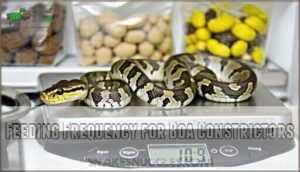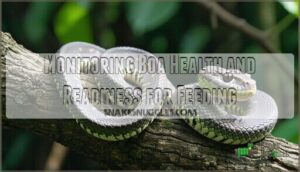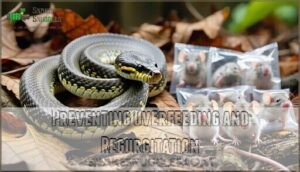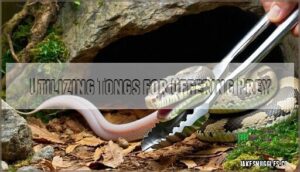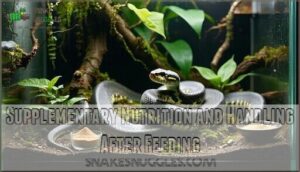This site is supported by our readers. We may earn a commission, at no cost to you, if you purchase through links.
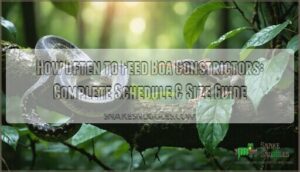 You’ll want to feed adult boa constrictors every 2-3 weeks, while juveniles need meals every 7-10 days.
You’ll want to feed adult boa constrictors every 2-3 weeks, while juveniles need meals every 7-10 days.
Your snake’s age, size, and body condition determine the exact schedule. Think of it like filling up a car’s gas tank – boas are incredibly efficient and don’t need frequent refueling like other pets.
Watch for feeding cues such as increased activity and tongue-flicking, which signal your boa’s ready for its next meal.
Temperature changes also affect appetite, so you’ll need to adjust during cooler months when metabolism slows down.
Getting the timing right prevents health issues and keeps your scaly companion thriving for years, which is a result of being incredibly efficient.
Table Of Contents
- Key Takeaways
- How Often to Feed Boa Constrictors?
- Feeding Frequency for Boa Constrictors
- Prey Size Guidelines for Boa Constrictors
- Monitoring Boa Health and Readiness for Feeding
- Meal Size and Feeding Process for Boas
- Supplementary Nutrition and Handling After Feeding
- Frequently Asked Questions (FAQs)
- How often should I feed a boa constrictor?
- How long can a boa constrictor go without eating?
- Can you overfeed a boa?
- What is a boa constrictor’s favorite food?
- How often should you feed a boa constrictor?
- How much do you feed a boa constrictor?
- Can boa constrictors eat fish or eggs?
- How long can a boa go without eating?
- Should I feed my boa in a separate enclosure?
- Can boas become picky eaters in captivity?
- Conclusion
Key Takeaways
- Age determines feeding frequency – You’ll feed juveniles every 7-10 days, while adults only need meals every 2-3 weeks, adjusting based on your snake’s metabolism and seasonal temperature changes.
- Match prey size to your boa’s girth – Choose prey that’s no wider than your snake’s thickest body section and weighs 5-12% of their body weight to prevent regurgitation and ensure proper nutrition.
- Watch for natural feeding cues – Look for increased activity, tongue-flicking, and hunting behavior to know when your boa’s ready to eat, rather than sticking rigidly to a calendar schedule.
- Allow proper digestion time – Wait at least 48 hours after feeding before handling your snake and avoid disturbing them until they’ve fully processed their meal to prevent regurgitation.
How Often to Feed Boa Constrictors?
Feeding your boa constrictor isn’t a one-size-fits-all approach. Age-Based Feeding determines your schedule: juveniles need meals every 7-10 days, while adults eat every 10-14 days.
The right feeding schedule isn’t about following rules—it’s about reading your individual snake’s unique needs and body language.
However, Individual Metabolism varies substantially between snakes. Seasonal Adjustments matter too—reduce feeding frequency during cooler months when metabolism slows.
Monitor Defecation Frequency as your guide; wait until your boa eliminates before offering another meal.
Overfeeding Risks include obesity and shortened lifespan, so resist the urge to "power feed." Your boa feeding schedule should flex with your snake’s body condition, behavior, and environmental factors for ideal health.
Maintaining proper humidity is key, as humidity aids digestion.
Feeding Frequency for Boa Constrictors
Your boa constrictor’s feeding schedule changes dramatically as it grows, starting with weekly meals for babies and stretching to every two weeks for adults.
You’ll need to adjust this timing based on your snake’s body condition, seasonal temperature changes, and individual metabolism to maintain ideal health.
Mimicking Natural Temperature Fluctuations
Since boa constrictors are ectothermic, their seasonal metabolism directly mirrors environmental temperature changes.
Winter’s chill slows their hunger—your boa’s metabolism dances with the seasons, demanding fewer meals when temperatures drop.
Cooling periods naturally slow digestion, requiring fewer meals during winter months. This temperature-driven feeding pattern supports their breeding influence and overall health.
Boa constrictors benefit from a proper temperature gradient creation.
- Summer warmth boosts their appetite and energy levels
- Winter cooldown triggers natural fasting periods
- Spring awakening restarts active feeding cycles
- Fall preparation builds reserves for cooler months
Environmental control through boa constrictor feeding schedule adjustments mimics wild seasonal rhythms, promoting ideal boa feeding frequency year-round.
Adjusting Feeding Schedule Based on Body Condition
Your boa’s body condition serves as your feeding compass.
A healthy snake maintains a square body shape with subtle back grooves.
Watch for obesity prevention signs like excessive wrinkling or ring-shaped fat deposits, which signal overfeeding.
Underweight indicators include visible spine and triangular body shape, showing underfeeding.
Regular body assessment helps you make proper feeding adjustments for consistent condition.
| Healthy Body Condition | Overweight Signs | Underweight Signs |
|---|---|---|
| Square body shape | Excessive wrinkling | Triangular body shape |
| Subtle back groove | Ring-shaped fat deposits | Visible spine |
| Proportionate appearance | Fatty liver disease risk | Reduced muscle tone |
Providing Gradual Transitions Between Feeding Schedules
When adjusting your boa constrictor feeding schedule, think of it like changing gears in a car—smooth phases prevent mechanical stress.
Abrupt changes can shock your snake’s system, so gradual adjustments over several weeks work best. Monitor your boa’s response to guarantee healthy adaptation.
- Age-Based Phases: Shift feeding intervals as your boa matures
- Seasonal Adjustments: Reduce frequency during cooler months naturally
- Individual Metabolism: Watch for unique feeding patterns and preferences
- Monitoring Weight: Track body condition throughout schedule changes
- Flexible Schedules: Adapt feeding frequency based on your snake’s needs
Prey Size Guidelines for Boa Constrictors
Selecting the right prey size is essential for your boa’s health, as feeding items that are too large can cause regurgitation while prey that’s too small won’t provide adequate nutrition.
You’ll need to match prey width to your snake’s thickest body section and adjust meal size based on your boa’s age, weight, and individual growth patterns.
Matching Prey Size to Snake’s Body Girth
The golden rule for boa constrictor feeding centers on matching prey to your snake’s thickest body section.
When measuring snake girth, the prey should never exceed this width to guarantee proper digestion. A proper prey weight ratio prevents regurgitation while providing adequate nutritional prey density.
Choose rodent size variety that creates only a slight bulge, maintaining safe boa feeding size standards for peak health. Adult boas often require larger prey, but genetics affect boa size, so observe your snake’s individual needs.
Prey Size Adjustments Based on Age and Weight
Proper prey selection changes dramatically as your snake matures. Getting the right size prevents digestive issues and promotes healthy growth throughout your boa’s life.
- Hatchling Prey: Start newborns with pinkie mice weighing 10-12% of their body weight, shifting to fuzzy mice as they grow.
- Juvenile Portions: Feed growing boas appropriately-sized rats every 7-10 days, maintaining the weight percentage rule for ideal development.
- Adult Prey: Mature snakes need larger prey variety less frequently, with meals comprising 5-7% of total body weight.
Wild boas survive thanks to slow metabolic rates, allowing them to endure inconsistent feeding schedules.
Monitoring Boa Health and Readiness for Feeding
You’ll need to watch your boa’s behavior and body condition to determine when it’s ready for its next meal.
Regular monitoring helps you adjust feeding schedules based on your snake’s individual needs and prevents both overfeeding and underfeeding issues.
Observing Hunting Behavior
Watching your boa’s hunting behavior tells you everything about their readiness to eat.
Hunting cues like increased movement and tongue flicking show they’re actively searching for prey.
You’ll notice improved strike accuracy and focused prey tracking when they’re truly hungry.
These appetite signs are your green light for feeding boa snakes.
Healthy boa constrictor feeding starts with recognizing natural feeding behavior.
A hungry boa becomes more alert, explores their enclosure, and responds quickly to movement.
If your snake ignores food or seems lethargic, something’s off.
Temperature changes often trigger these responses, so check your heating first before worrying about illness.
Maintaining Feeding Logs
Tracking your boa constrictor feeding schedule through detailed logs creates a foundation for Long-Term Health monitoring. Data Accuracy becomes your best friend when identifying patterns and making Schedule Adjustments.
Document each feeding session to spot Individual Variation in appetite and digestion.
Essential details for your feeding log include:
- Feeding dates and prey weights
- Defecation timing and consistency
- Body condition observations
- Behavioral changes or appetite shifts.
This Trend Analysis helps optimize your boa feeding guide approach.
Consulting a Veterinarian for Concerns
While detailed feeding logs help track patterns, some health problems require Expert Feeding Advice from reptile veterinarians.
If your boa refuses food for three weeks, shows Regurgitation Issues, or displays unusual behavior, seek professional help immediately.
Vets can identify Dietary Deficiencies, snake health issues, and provide Preventative Care strategies for ideal Weight Management and long-term snake care.
Meal Size and Feeding Process for Boas
You’ll need to select the right meal size and follow proper feeding techniques to keep your boa healthy and prevent regurgitation.
Understanding how to prepare frozen-thawed prey, use feeding tongs safely, and recognize signs of overfeeding will guarantee successful feeding sessions every time.
Preventing Overfeeding and Regurgitation
Keeping your boa constrictor healthy means avoiding the twin dangers of overfeeding and regurgitation.
Stick to prey that’s no wider than your snake’s thickest body section, and maintain consistent feeding intervals to support proper digestion.
- Obesity Risks: Overfeeding leads to fatty liver disease and shortened lifespan
- Regurgitation Causes: Oversized prey or handling too soon after meals
- Proper Digestion: Allow 7-10 days between feedings for complete processing
- Prey Size: Match meals to your boa’s girth, never exceeding body width
Using Frozen-Thawed Prey and Proper Warming Techniques
Most boa constrictor feeding success starts with proper thawing methods. Place frozen prey in your refrigerator overnight, then warm it in sealed bags using warm water to reach 98-100°F.
Warming safety matters—never microwave prey, as this creates dangerous hot spots. Avoiding bacteria through controlled thawing preserves nutritional impact while ensuring safe prey presentation.
These thawing techniques and careful prey handling prevent improper thawing that could harm your snake.
Supplementation is often necessary to avoid nutritional deficiency issues.
Utilizing Tongs for Offering Prey
Once your frozen prey reaches proper temperature, grab a pair of tongs for safe prey presentation.
This simple tool prevents accidental bites during boa constrictor feeding while maintaining proper hygiene practices.
Tongs safety keeps your scent off the meal, making feeding techniques more natural.
Your snake won’t associate your hands with food, reducing bites and minimizing stress.
Smart prey handling protects both you and your boa during every feeding session.
Many owners find specialized feeding tools helpful.
Supplementary Nutrition and Handling After Feeding
You’ll need to supplement your boa’s diet with calcium and vitamin D3 to prevent metabolic bone disease, especially when feeding frozen prey.
After feeding, avoid handling your snake and minimize cage maintenance for at least 48 hours to allow proper digestion and prevent regurgitation.
Using Necessary Calcium and Vitamin Supplements
Proper calcium supplementation acts as your boa’s nutritional safety net. Even high-quality feeder rodents can’t provide everything your snake needs for ideal health.
You’ll need to dust prey items with calcium powder containing Vitamin D3 every other feeding to prevent metabolic bone disease. A lack of proper supplementation can lead to vitamin deficiency signs.
- Lightly sprinkle Repashy Calcium Plus over prey before offering
- Gut-loading prey with nutritious foods 24 hours before feeding enhances nutritional value
- Maintain consistent supplement frequency based on your boa constrictor feeding schedule
Balanced nutrition requires this simple but essential step in your boa snake diet routine.
Allowing Digestion Time and Minimizing Cage Tasks
After feeding, your boa needs undisturbed digestion time. Wait 48 hours before handling to prevent regurgitation risk. Essential cage cleaning can continue, but minimize handling and avoid unnecessary disturbances.
Some owners find that aiding boa digestion can be beneficial.
| Post-Feeding Timeline | Recommended Actions |
|---|---|
| 0-48 hours | No handling, minimal cage stress |
| 48-72 hours | Light maintenance only if essential |
| 3-7 days | Monitor defecation frequency |
| 7-14 days | Normal handling can resume |
| Ready for next meal | Check digestion monitoring signs |
Frequently Asked Questions (FAQs)
How often should I feed a boa constrictor?
Like a clock ticking steadily, your boa’s feeding schedule depends on age.
You’ll feed juveniles every 5-7 days, adults every 10-14 days.
During cooler months, extend intervals to 4-8 weeks as their metabolism naturally slows down.
How long can a boa constrictor go without eating?
Adult boa constrictors can survive 4-8 weeks without food, while juveniles shouldn’t go beyond 2-3 weeks. Your snake’s metabolism slows during cooler months, naturally extending fasting periods without health concerns.
Can you overfeed a boa?
Yes, you can overfeed a boa, and you should avoid it.
Overfeeding leads to obesity, fatty liver disease, and shortened lifespan.
Monitor your snake’s body condition and stick to appropriate feeding schedules.
What is a boa constrictor’s favorite food?
Your boa doesn’t really have "favorites" like we do. In the wild, they’ll eat birds, mammals, and reptiles. Captive boas thrive on appropriately-sized rats and mice, which provide complete nutrition.
How often should you feed a boa constrictor?
Feed young boas every 5-7 days, juveniles every 7-10 days, and adults every 10-14 days.
You’ll need to adjust frequency during cooler months, allowing 4-8 weeks between meals based on your snake’s individual needs.
How much do you feed a boa constrictor?
Contrary to popular belief, you shouldn’t eyeball portions. Feed your boa prey that’s 10-12% of its body weight, matching the snake’s thickest part. Weigh both snake and prey for accuracy.
Can boa constrictors eat fish or eggs?
While your boa can technically eat fish or eggs, these aren’t ideal foods.
Stick to rodents like mice and rats for proper nutrition.
Fish lacks essential nutrients, and eggs don’t provide balanced protein your snake needs.
How long can a boa go without eating?
Your boa can surprisingly survive months—even up to six months—without eating.
Adult boas naturally fast during cooler seasons, while juveniles shouldn’t go beyond four weeks.
Monitor their weight and behavior closely during extended fasting periods.
Should I feed my boa in a separate enclosure?
No, you shouldn’t feed your boa in a separate enclosure. Moving them causes stress and can trigger regurgitation. Feed directly in their primary habitat where they feel secure and comfortable.
Can boas become picky eaters in captivity?
While you might worry your snake’s being stubborn, yes, captive boas can develop feeding preferences.
They’ll often refuse certain prey sizes, colors, or types they’ve grown accustomed to, requiring patience and gradual dietary adjustments.
Conclusion
Mastering how often to feed boa constrictors isn’t complicated when you understand their natural efficiency. Your snake’s age, size, and environmental conditions will guide the perfect feeding schedule.
Adults thrive on meals every 2-3 weeks, while juveniles need weekly feeding. Watch for hunting cues, maintain proper temperatures, and choose appropriately-sized prey.
With consistent monitoring and proper technique, you’ll keep your boa healthy and content. Remember, these remarkable serpents have evolved to be incredibly efficient feeders.
- https://www.cdc.gov/nutrition/infantandtoddlernutrition/breastfeeding/how-much-and-how-often.html
- https://snakerambles.tumblr.com/post/144818463409/feeding-your-boa-imperator
- https://www.mayoclinic.org/drugs-supplements-vitamin-d/art-20363792
- http://mailto:hello
- https://www.ncbi.nlm.nih.gov/pmc/articles/PMC4005007/

